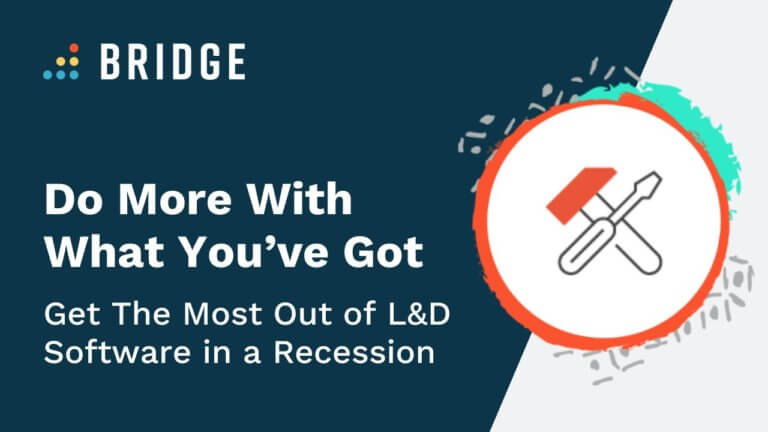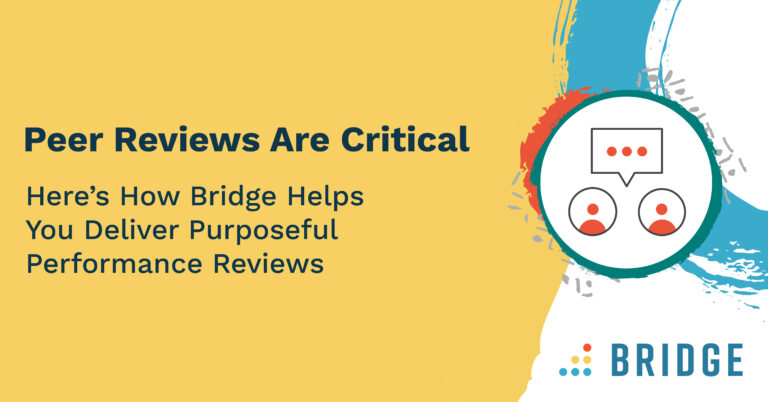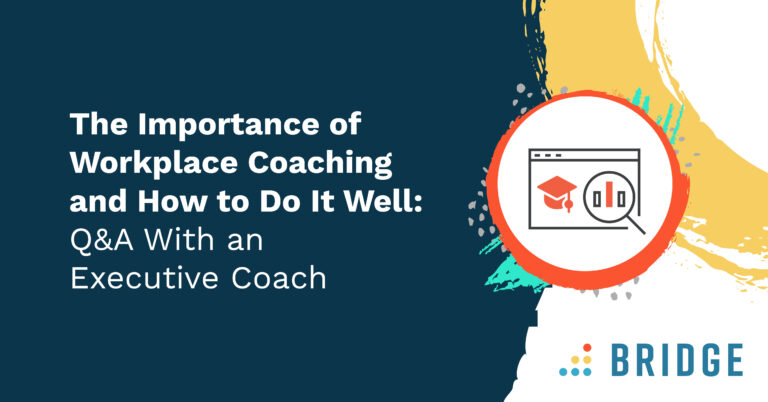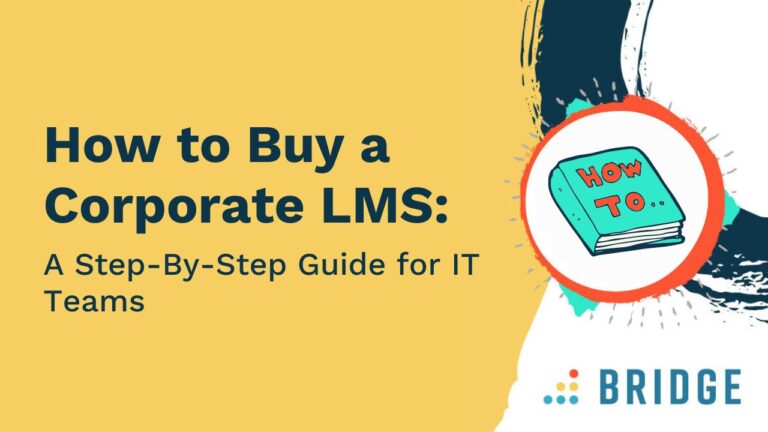In economically challenging times, tight budgets and the need to trim costs can call investment opportunities into question.
According to Deloitte research, although 93% of business leaders say using technology to improve outcomes and team performance is vital for business success, there’s a massive readiness gap. In the face of uncertainty, many are cautious about investing, and just 22% are ready to embrace tech-related opportunities.
For L&D teams, this reluctance to invest in tech during times of economic uncertainty can make it difficult to secure learning and development budgets or justify buying an LMS. You can overcome this challenge by persuading your organization to see the value of L&D and view software as an investment rather than a cost.
Review existing tools and technologies and make the best decisions for what you need by sharing the impact of L&D objectives and reframing how a data-led approach to talent and skills development benefits your organization and people.
Recruit, Reskill, Retain: 4 Cultural Shifts Ramping Up the Need to Buy an LMS
Financial uncertainty can threaten investment opportunities in areas like L&D, as leaders strike the right balance and invest in areas that offer both short and long-term value and growth.
A successful purchase requires a close examination of the current landscape, the need for learning and development, and a clear plan about how your organization can benefit from buying and using software to reskill and retain top talent and remain competitive.
1) Attracting Talent to Fill Skills Shortages
According to McKinsey, 45% of organizations report skills gaps, and nearly 90% of senior execs feel unprepared to deal with digital skills shortages. Faced with rapid technological advancements, shifts in business processes, and the aftermath of The Great Resignation, many organizations lack the talent needed to survive and thrive.
The intent to hire may be strong, but many organizations are under pressure to find the skills they need. Data compiled by job site Monster shows even in the face of economic adversity, companies are doubling down on efforts to compensate for talent shortages, fill vacancies, and attract skilled candidates.
Results reveal that:
- 92% of companies plan to hire for new roles or backfill existing positions
- 87% say they struggle to hire as a result of skills gaps
- 42% believe that increased competition for talent will make recruiting harder
As a result of the increased competition for talent and widening skills gaps, more organizations are looking to their current talent to fill skills gaps. Using an LMS to deliver training programs is an effective way to identify skills gaps, swiftly respond to need, and develop a workforce with the agility to overcome challenges.
EXPLORE MORE RETURNS ON INVESTMENT FROM L&D PROGRAMS | ‘Making the Case for Your Learning Platform in a Time of Economic Uncertainty’
2) Reskilling to Retain Existing Talent
Making short-term cuts during economic dips can be costly in the long term, and failing to invest in the areas that employees value has the potential to impact retention.
Data from Amazon and Workplace Intelligence finds that, despite employees’ financial fears, many are willing to look for employers who prioritize career development, and nearly three in four will likely leave their current roles due to an absence of skill-building or career mobility options.
According to the survey, 78% of employees are concerned that they lack the skills needed to advance in their careers and feel unprepared for the future of work.
As a result, they’re taking matters into their own hands, and 83% report that improving skills is a top priority. Opportunities to develop and grow are the expectation for 80%, and for employers failing to invest in people and the platforms to deliver personalized training experiences, attracting and retaining talent could be tricky.
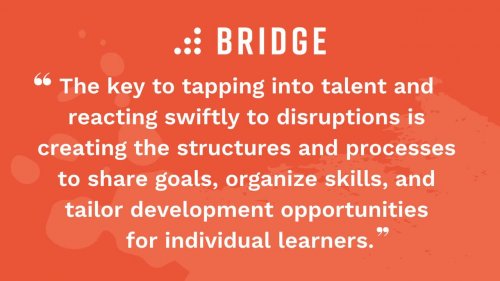
UNLOCK YOUR LEARNERS’ SKILLS | ‘How Talent Mobility Empowers Employee Development’
3) Responding to Change With a Skills-Based Strategy
As advancements in digital technologies and tools change the nature of jobs, organizations are returning to the drawing board to review how they approach jobs and skills.
Deloitte’s data shows that, driven by technologies such as automation and AI, an era of fast and unpredictable change calls for a new approach, and 77% of leaders and HR execs believe that a skills-based strategy is crucial to navigating future disruptions. However, only 14% say they currently use skills and capabilities to their full effect.
The results show that 85% are redesigning how they build and deploy skills, allowing them to place talent more effectively, respond to change, and close skills gaps. The key to tapping into talent and responding swiftly to disruptions is creating the structures and processes to share goals, organize skills, and tailor development opportunities for individual learners. An LMS makes it quick and easy to visualize data, respond to business priorities, and deploy training, helping to minimize disruption.
L&D STRATEGIES FOR WORKPLACE SUCCESS | ‘Does Your L&D Approach Meet the Needs of Today’s Learner?’
4) Driving Performance With a People-Centric Approach
The need to make the best spending decisions means decision-makers must weigh the initial cost of an LMS against the return on investment and look at what kind of solution can meet business needs and priorities.
To the organizations that make considered investments, ‘engagement’ and ‘satisfaction’ are more than buzzwords. As McKinsey’s research shows, companies that actively pursue employee skill-building, consistently measure results, and build collaborative systems and culture achieve around 30% higher revenue growth for every dollar invested in employee development than their counterparts. The right LMS can drive performance objectives and boost employee engagement by centralizing data and aligning organizational goals.
Successful organizations see employee development as more than just a checkbox exercise. Those that drive profit understand the value of investing in their people and actively work to develop the skills their organization needs.
SHOWCASE THE VALUE OF LEARNING AND DEVELOPMENT | ‘How to Get Your CEO to Increase L&D Budgets’
4 Ways to Increase the Value of L&D Investments With Purposeful Results
While investments might have been a quick fix for some organizations to address challenges, tighter budgets demand a deeper understanding of the purpose and goals behind purchasing tech. Stakeholders need to know that spending on a learning platform will generate revenue and drive growth.
A review of L&D spend in these challenging economic times is a chance to evaluate why your business invests in technology, to more closely align L&D goals against business needs, and maximize investment potential with a shared purpose.
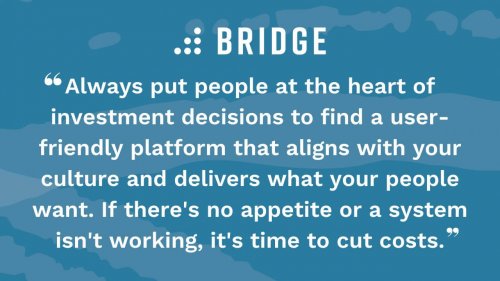
1) Revisit and Redefine Investment Goals
Investing in a learning platform without demonstrating actionable change won’t give your business the returns it seeks. It’s not about showing off your tools and technologies simply to prove that you invest in development—you need clear goals and consistent metrics to showcase your return on investment.
The first step is to evaluate what technology is already being used, its original purpose, and whether it’s meeting those needs. If you want to understand the value of an investment, ask yourself: is it meeting its intent? What has it increased, saved, or improved as a result?
If leaders are keen to make cuts, it could be time to look at what programs and platforms can be removed, changed, or replaced with a more cost-effective way to deliver training and development. For example, if your organization uses multiple HR software systems, look for a way to consolidate or streamline processes into a single platform.
REVIEW YOUR CULTURE AND GOALS | ‘Creating a Culture of Conversation’
2) Look at Employee Adoption Rates
If a given piece of technology hasn’t been adopted by your employees, or if they exhibit some resistance, it’s time to evaluate whether there are any barriers. It could be a quick fix like a platform that’s hard to navigate, a gap in employee knowledge, or a solution that doesn’t meet learner needs.
Always put people at the heart of decisions and find a user-friendly platform that aligns with your culture and their needs. The data will reveal what’s working, but don’t forget to ask people for feedback. If there’s no appetite or a system isn’t working, it’s time to cut costs.
Communication should always be ongoing, and you should give people the chance to offer feedback without fear of criticism. With a list of objections, priorities, and preferences, you can find a solution suited to learners’ needs and deliver the training they want in preferred formats.
Honest and authentic conversations with managers and leaders can set expectations for what’s ahead and increase confidence in tech adoption. Gartner survey results highlight the benefits of involving people in processes—when organizations connect people to culture, it can increase employee performance by up to 37% and retention by up to 36%.
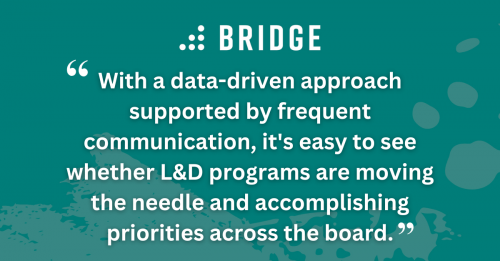
GIVE YOUR PEOPLE THE SKILLS TO SUCCEED | ‘How to Retain Your Best Employees’
3) Show the ROI of L&D Investments Through Shared Objectives
Learning and development teams need to be at the center of business decisions, working to deliver programs and strategies that align with strategic priorities throughout the organization.
According to LinkedIn’s Workplace Learning Report, 77% of L&D professionals say their role has become more cross-functional, and 81% are working alongside organizational leaders to build a more people-centric culture. Increased remits and tighter budgets can create the opportunity to show L&D as a necessity across the organization.
By giving your L&D team a more business-centric role, you’ll be in a better position to reframe your learning platform for its return on investment and demonstrate its value on the most critical goals and priorities. Go beyond the features and tie tech to measurable benefits like growth and revenue from learning and skill-building initiatives to show the strategy behind L&D programs and how your team feeds into these goals.
With a data-driven approach supported by frequent communication, it’s easy to see whether L&D programs are moving the needle and accomplishing priorities across the board. When stakeholders and decision-makers across the business see the value of L&D programs and software, justifying investments and budgets becomes more straightforward.
CONVERSATION-STARTERS TO BOOST YOUR L&D BUDGET | ‘How to Create an L&D Budget You Can Defend to Your CFO’
4) Check That Your LMS Vendor Is Aligned With Your Organization’s Goals
The value of a partnership with your vendor can’t be understated. Building a strong relationship with a software provider that understands your organization’s goals and objectives will create and sustain the maximum value.
Be critical about the services your organization and learners need, and communicate these needs and goals to find a solution that works. Collaboration is key—by bringing stakeholders in on the decision and identifying shared goals, they can share knowledge on the providers best suited to needs and priorities such as data and compliance, and see firsthand how L&D programs add value.
It takes research to find a provider that aligns with your culture, offers ongoing support, and adapts to meet current and future needs. Trust matters, so use reviews to determine how they work with existing customers.
FIND A SOFTWARE SOLUTION THAT MEETS YOUR NEEDS | ‘How to Choose an LMS for Your Organization’
Make the Most of Your L&D Investment With Bridge
Futureproof your L&D strategy with Bridge’s LMS. Refine your training programs to unlock skills, boost productivity, and drive a measurable return on performance goals.
With ongoing, 24/7 support from our team of experts, we’ll work alongside you to deliver intuitive skills development in an easy-to-use platform. Bridge makes it simple to measure learning outcomes against organizational goals, monitor employee engagement, and achieve maximum impact from minimum spend.
